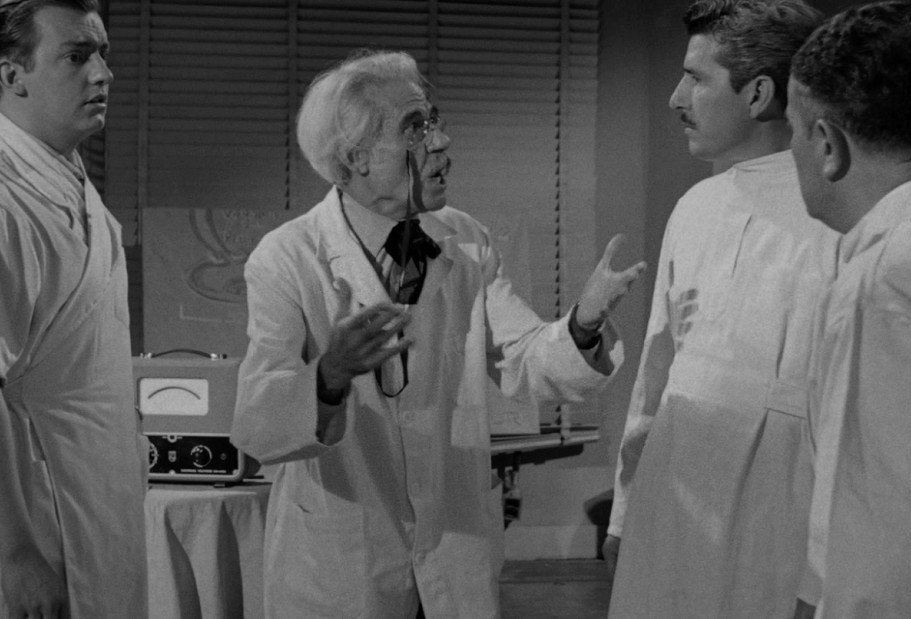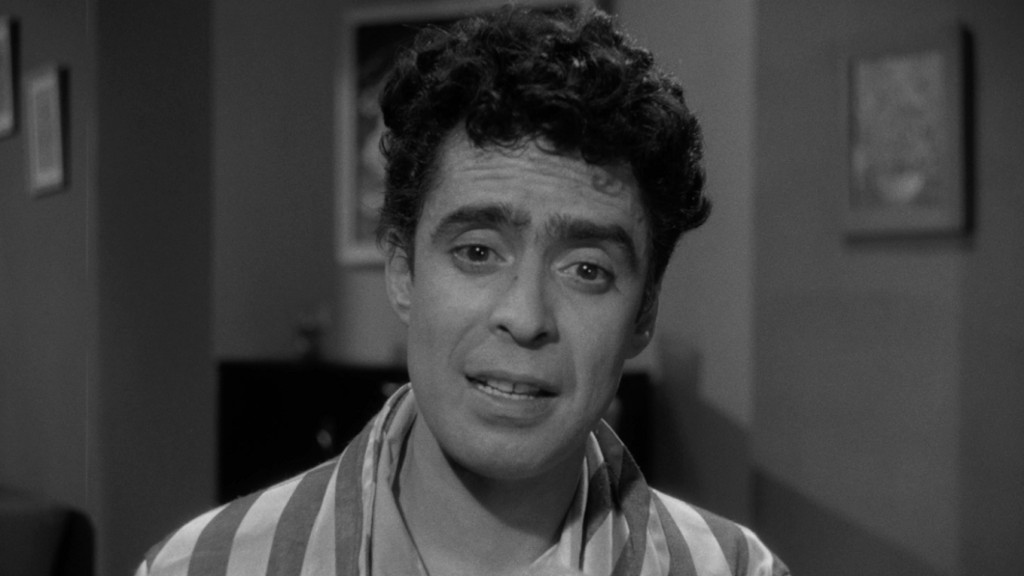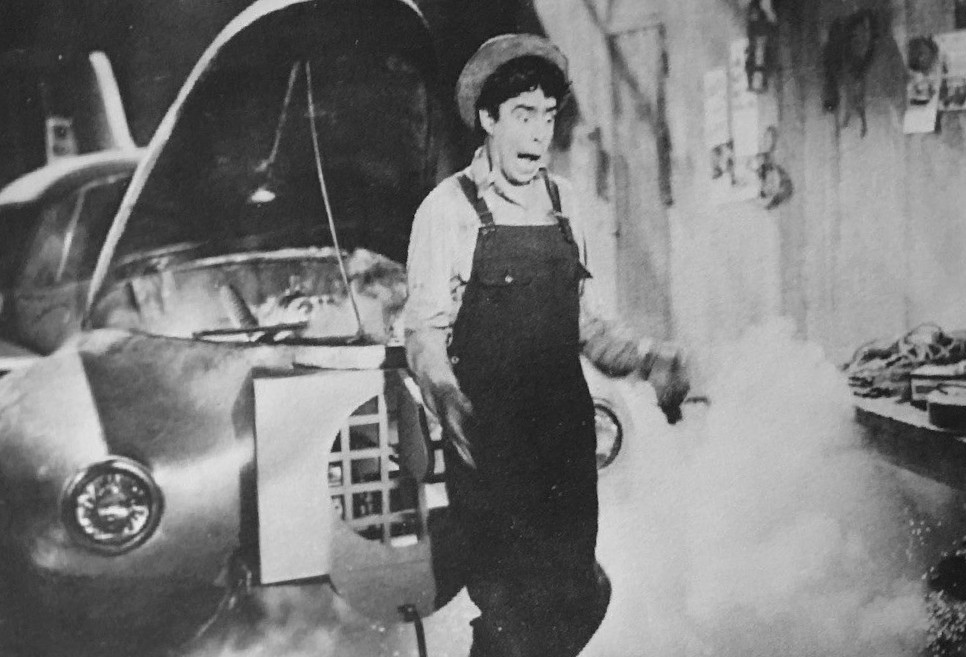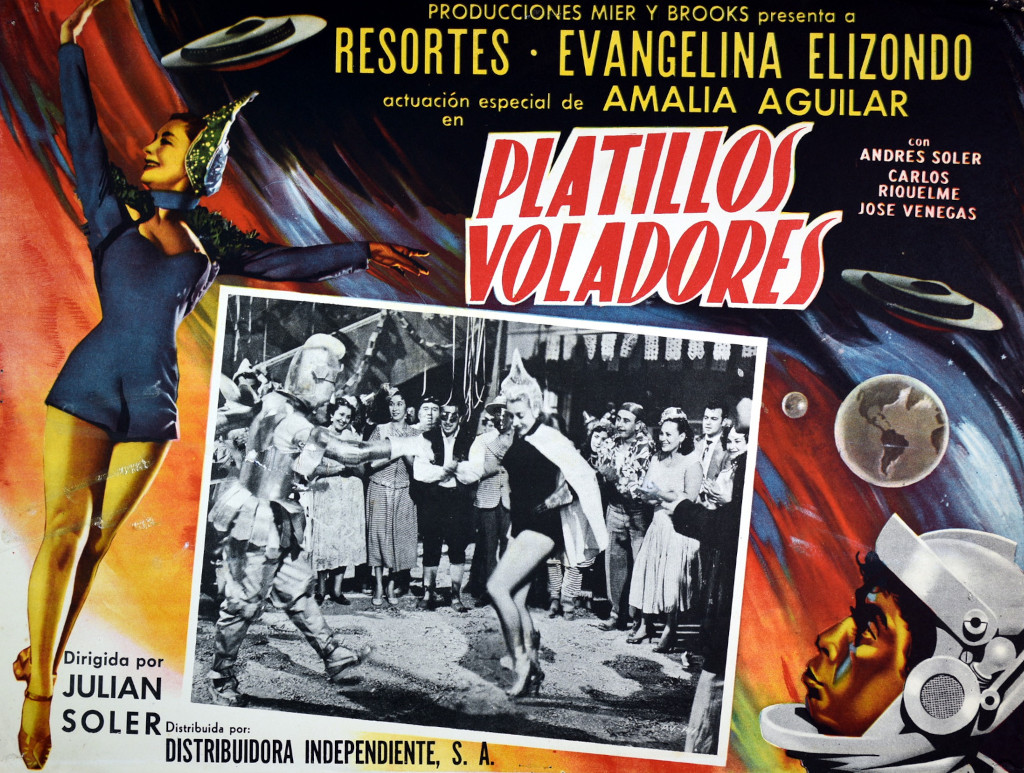
A poor young couple escape their small town in a rocket car and crash land in Mexico City, where they are mistaken for Martians. This Mexican 1956 musical comedy is thin on plot and substance, but charms with its good cast and sincerity. 6/10
Los platillos voladores. 1956, Mexico. Directed by Julián Soler. Written by Carlos Leon, Carlos Orellana, Pedro de Urdimalas, Julián Soler. Starring: Adalberto “Resortes” Martínez, Evangelina Elizondo, Andrés Soler, Amalia Aguilar. Produced by Óscar J. Brooks & Felipe Mier. IMDb: 5.6/10. Rotten Tomatoes: N/A. Metacritic: N/A.

A young couple in a small town in Mexico, Marciano and Saturnino (Adalberto Martínez and Evangelina Elizondo), dream of a better life together. Marciano hopes their dreams will be fulfilled with the help of a silver racing car with fins and an airplane engine he has been building in his shed. One night, during a masquerade party, where the two dress up as aliens, a fight breaks out between Marciano and a romantic rival, Venustiano (José “El Bronco” Venegas). Marciano and Saturnino escape with their car, but Marciano can’t control the airplane engine, and the two take off to the skies and crash outside of Mexico City. When they are discovered unconscious, they are mistaken for Martians, and brought to Professor Saldaña (Andrés Soler) and his assistant Bailarina (Amalia Aguilar).
As they awake, the couple decide to play along with the farce, pretending to be aliens, in the hopes of gaining fortune and the new life they have been wishing for. Meeting with scientists and the press, the two describe Mars as a pacifist haven, where wars, greed, poverty and strife have all been eradicated through science, kindness and love. Soon offers arrive for product endorsements, and Marciano and Saturnino suddenly get a taste of a life of luxury. During a press conference, they deliver a powerful speech of peace, brotherhood and love, warning humanity not to go forth with their atom and hydrogen bombs, lest they risk destroying themselves. Escaping their luxury hotel, the two go out incognito into the night, remembering what it was to be “just two fools in love under the full moon” and with the aid of a long song and dance number, decide to confess their hoax to the kind professor Saldaña. However, when they confront him, he tells them he knew the truth all along. When they offer to return all the money they have received, Saldaña tells them to keep it, take it back to their poor village and use it as best they see fit to help others. He will keep their secret. The next morning, Saldaña announces that the Martians have gone home in a flaming disc.

Well, I suppose the flying car defends this film’s inclusion on a science fiction blog. Otherwise there is precious little SF in this Mexican 1956 movie. Los platillos voladores translates as “The Flying Saucers”, but in a twist that must have been a terrible disappointment to Mexican kids, this films is actually a musical comedy about a flying saucer hoax. In a way, it reminds me of The Flying Saucer (1950, review), America’s first flying saucer movie. It was heavily marketed as a film about UFO’s and aliens, but to the deep resentment of all SF fans who watch it, it makes clear from the very beginning that it’s about an experimental Soviet airplane being tested somewhere in Alaska. Kids who had expected to see little green aliens, were instead stuck for an hour watching writer/producer/director/star Mikel Conrad grump it out in an Alaskan cottage, hoping a Russian spy will materialise out of thin air before him.

Los platillos voladores was certainly not the first science fiction movie produced in Mexico — at least a dozen of them had been made since the 30’s. However, all of them fall into two distinct parent categories: horror or comedy. The first (at least preserved) Mexican SF movie is a mystery film called The Dead Speak (1935, review), in which the lead was incidentally played by the director of Los platillos voladores, Julián Soler. The film set the tone for the 30′ and early 40’s, which were represented by dark, Universal-inspired medical horrors. Then in 1946 came the ill-conceived Boom in the Moon (review) by Jaime Salvador, starring a washed-out Buster Keaton in one of the worst movies ever made. This then, became the blueprint for the Mexican SF comedy, which blossomed in the late 40’s and 50’s.
The gag used in Los platillos voladores had actually been used before, but in reverse, in Boom in the Moon. In that film, Buster Keaton and two friends accidentally land their moon rocket in Mexico City, but spend the entire film believing they are on the Moon. However, in tone and style, Los platillos voladores is probably closest to Una movida chueca (review), also released in 1956. Like Platillos, it is a rags-to-riches musical comedy featuring a street smart man of the people elevated to society’s darling through the means of SF. In Platillos, the lead character is played by Resortes, the artist name of Adalberto Martínez. Resortes was a representative of a very archetypical Mexican comedic character — the commoner, almost always broke, a bit of a hustler with a heart of gold, dumb enough to place himself in all sorts of troubles, but street smart and lucky enough to wiggle his way out. Inevitably the films involving these characters would have some sort of class element: Resortes and his colleagues would suddenly find themselves in a pinch in the upper echelons of society, giving the films a chance to satirize the greed and buffoonery of the aristocracy, while giving the lead character and chance to realise where he belongs — not among the stiffs shirts of the bourgeoisie, but with the people. He may be poor, but at least he’s happy. In a weird sort of way, these movies, despite their seeming class disdain, end up reinforcing prevailing class structures.

The character that these comedians all played their own version of more or less originated with Cantinflas (Mario Moreno-Reyes) in the late 30’s. Cantinflas’ velvety, dark charm combined with his bad boy attitude and energetic, fast-talking performance and his over-the-top mugging and aptitude at physical comedy quickly made him the biggest movie star in Mexico. Scores of imitators followed, many of whom became hugely successful in their own right. One was Clavillazo, who can be seen in Una movida chueca, and another one Resortes, whose artist name means “spring” or “coil”, giving you an idea of his performance style. Particular for these underdog comedies were that they often had a somewhat far-fetched plot, which was nevertheless played straight by the rest of the cast, dropping the comedian into the mix like an odd comic book character, seemingly somehow detached from the rest of reality. They all seemed to employ a particular sort of exaggerated mugging that looks copied from cartoons, and which makes for a kind of comedy that seems very odd to a non-Mexican, modern audience.

That’s the backdrop against which this film should be watched. So, is it any good? Well, taken for what it is, it is at least not terrible. It seems to have had a decent budget. There are two large, almost Busby Berkeley-style musical numbers, and the production values are OK for Mexican standards at the time. The musical numbers are not particularly well filmed, but the songs are quite catchy and the cinematography overall is more or less what you’d expect from a Hollywood film of the same calibre. If I remember correctly, there are five or six long musical numbers in the movie, with rather little plot in between, thus resembling the musical comedies of Hollywood in the late 20’s and early 30’s. I wouldn’t call it laugh-out-loud funny, and Resortes’ mugging does get on your nerves from time to time. I watched the film on Youtube with automatically generated Spanish subtitles automatically translated by Google, so I’m sure that some of the verbal comedy flew past me, but what I did understand was at least slightly amusing, and the film’s sugary sweet conclusion, a cotton candy version of Michael Rennie’s final speech in The Day the Earth Stood Still (1951, review) was quite sympathetic. Sometimes a sappy, happy ending can be rather refreshing.

The acting is quite good across the board. When he refrains from mugging, Resortes is not a terrible actor, even if he sees himself out-acted by his companions. Evangelina Elizondo has a natural and sympathetic air about her, and she is very cute and lively, which, I suppose, is her task in the film. Veteran Andrés Soler brings both gravitas, comic timing and a warm kindness to the role of the Professor, and loud, expressive Amalia Aguilar is appropriately annoying in her role as the assistant who gets a crush on Resortes. El Bronco is in the film to look scary and sing a ballad, both of which he does with bravado, and Carlos Riquelme in a small supporting role as Saturnina’s father provides good support.

Los platillos voladores is another one of those extremely rare films that have been difficult for SF fans to track down for a long time, and are now interesting only for genre completists. It has, however, been available on Youtube for a while, but despite this, it only has almost no audience votes in its 5.5/10 IMDb rating. It has a 1.5/5 rating at AllMovie, with no review or even plot synopsis, giving me the impression that no-one at the site has actually seen it. Pedro Paunero at Corre Camara calls the film “nothing more than a parody of American Sci Fi, which avoids delving into the genre, and is nothing more than another coarse comedy”. El Heraldo Aguascalientes also has little good to say about Platillos: “As clumsy as its protagonist, the film passed without much notice”. The only English-language review I have come across is written, unsurprisingly, by Dave Sindelar at Fantastic Movie Musics and Ramblings. Sindelar has seen the film without subtitles and “found it very difficult to follow”; “Some of the humor is fairly clear; there’s a lot of mugging, for example, and, quite frankly, I haven’t seen this much eyebrow bobbing since my last Groucho Marx movie. There’s also a subplot about a tall lanky girl getting the hots for the man mistaken for a Martian. The musical numbers are weird, though I can’t really call them memorable. […] To be honest, this one doesn’t look too promising.”

I liked the film better than all the above critics. I mean, sure, it’s a clumsy and rather pointless piece of entertainment built around its musical numbers. It ain’t no masterpiece. But unlike the film of my previous review, Croisères sidérales (1942), it doesn’t feel like it fails to take advantage of an interesting premise, because the premise is just silly. And unlike, say, the British comedy Once in a New Moon (1934, review), it doesn’t build up tension with multiple political and social issues being hotly debated, before they are all just dumped by the curb, unresolved, in a deus-ex-machina plot twist. It’s got a silly premise which it remains faithful to and resolves at the end, never violating its own logic in the process. That’s more than you can say about at least half of the movies I’ve reviewed on this blog. It’s got a cheesy and naive resolution: “be kind to each other”, but it’s sincere, as this is a cheesy and naive film, and sometimes that is enough. I was entertained and seldom felt annoyed.
Director Julián Soler was the youngest brother of the so-called Soler Dynasty, a group of five siblings who all rose to prominence during the Golden Age of Mexican cinema in the 30’s. The Soler’s parents were Spanish theatre actors who emigrated to Mexico in 1898, and also lived for longer stretches in Los Angeles, US, and Ecuador. Out of 10 children, five: Fernando, Andrés, Domingo, Julián and Mercedes became renowned actors. Fernando and Julián also worked as directors. Mercedes was born in Los Angeles, where some of the siblings are said to have done bit-parts in silent films. Working on stage in Mexico in the 20’s, the Solers became a power factor in Mexican theatre, together and apart. It was Fernando who first entered the movie business, in a Spanish film made in Paris in 1932. Mercedes was the first to appear in a Mexican movie in 1933. Julián made his screen debut in 1934. During his career he performed in close to 60 movies between 1934 and 1978, the best remembered being the classic Doña Bárbara with María Félix, who would go on to become Mexico’s biggest movie star, in a career-defining role, opposite Julián’s leading man.

However, while successful as an actor, Soler became more interested in directing and made his directorial debut in 1943 with the romantic drama Tormentia en la cumbre, in which he also starred. During his career he directed over 80 films, primarily comedies and dramas. While never counted among the top directors of Mexico, he had a few hits, like the Zorro-inspired Cruz Diablo (1934), the mystery drama La mujer X (1955), which introduced multiple Ariel award winner Alejandro Parodi to a broad audience, the romantic drama La tercera palabra (1956), which was the first of four films to team up Sara García and Prudencia Griffel as the kick-ass granny sisters Matilde and Angelina, as well as the horror anthology Panico! (1966). He also directed the very well regarded the SF-tinged horror comedy El castillo de los monstruos (1958, also with Evangelina Elizondo) and the lucha movie Santo vs. Blue Demon in Atlantis (1970). In the book Screen Sirens Scream!, leading lady Evangelina Elizondo calls Soler “a very good director, but a little bit neurotic”.

Lead actor Adalberto “Resortes” Martínez was born in Mexico City, one of 18 children, and started appearing on stage at the age of 15. He worked in theatre, vaudeville and the circus as an actor, comedian and tap dancer, and in 1947 made his movie debut in Jaime Salvador’s Voces de primavera. Already in next year’s El nieto del Zorro, he was the star. During his career he participated in over 100 films and TV shows to great success. His real breakthrough film was Chano Urueta’s musical comedy Al son del mambo (1950), and he followed up with hits like El beisbolista fenómeno (1952), El rey de México (1956) and Asesinos, S.A. (1957). When the popularity of his particular style of comedy started to fade in the 60’s, he accepted supporting roles, and got recognition as a serious actor as well. For his supporting role in the murder mystery Los albañiles (1976) he was awarded with a Best Actor award by the Mexican wing of ACE. He also starred in the family movies The Girl with the Blue Backpack (1979) and The Girl with the Blue Backpack 2 (1981). In the Martínez landed a featured supporting role in the well-regarded and hugely popular family adventure telenovela El abuelo y yo (1992), starring a very young Gael Garcia Bernal. Evangelina Elizondo remembers Resortes as “a fantastic dancer” but “very eccentric”.

Lead actress Evangelina Elizondo was a remarkable woman. At a young age she excelled as a painter and got degrees in both art and theology, and had a keen interest in singing and dancing. She started her film career as the Spanish voice of Disney’s Cinderella in 1950, when she won a contest during her studies at the university, according to an interview in the book Screen Sirens Scream! by Paul Parla and Charles P. Mitchell. This opened the door for her for both stage work and later movies — she specialized in comedy and musicals, as she says her real passion was singing and dancing, and she wasn’t that interested in dramatic roles. In Screen Sirens Scream! she lists all her three SF movies; Los platillos voladores (“an excellent picture”), El castillo de los monstruos (1958, with Clavillazo) and El superflaco (1959). During the 70’s and 80’s Elizondo partly retired from film work, but made a bit of a comeback in TV in the late eighties — first co-starring with Resortes in El abuelo y yo (1992), and then making a splash as Doña Emilia in the telenovela Mirada de mujer, which led to more featured telenovela work in the 2000’s. Furthermore, Elizondo has recorded several music albums, was a respected artist and published a book on art and a book on philosophy. She passed away in 2017.

Andrés Soler, of course, was the brother of director Julián, and part of the Soler clan. While he didn’t command that many romantic leading roles, he was one of the most respected character actors of the Golden Age of Mexican cinema, often third or fourth billed behind the romantic leads. Very often Soler was teamed up with Cantinflas, like in the comedy versions of The Tree Musketeers (1942), where he played Athos, Romeo and Juliet (1943), where he played Capulet or A Day with the Devil (1945), in which he plays the devil. Between 1950 and 1955 he was nominated for the Silver Ariel for best supporting actor four times, but never won. Between 1934 and his death in 1969 he appeared in almost 200 films. Apart from Los platillos voladores, he appeared in five SF films: The Hell of Frankenstein (1960), The Astronauts (1960), El monstruo de los volcanes (1963),
El terrible gigante de las nieves (1963) and La mano que aprieta (1966).

Amalia Aguilar was a Mexican singer, dancer and comedian of Cuban descent, what was in the trade called a “rumbera”. Originally a dancer and singer, she rose to some fame in Cuba before relocating to Mexico, where she made her film debut in 1946. She tried her luck in Hollywood in 1947, where she performed on stage and took part in the film A Night at the Follies and a couple of dance shorts. However, dissatisfied with Los Angeles, she returned to Mexico, where she continued her career as a stage singer and dancer, and went on to appear in over 20 movies, not seldom in leading roles in musical comedies. She appeared in one of Buster Keaton’s Mexican movies, El Colmillo de buda (1949) and opposite Resortes in Al son del mambo. For a handful of sexploitation comedies she teamed up with Lilia del Valle and Silvia Penal in order to play “three sexy nurses” or “three merry widows” caught up in adventure. She retired from the screen in 1958.
Writer Carlos Orellana also co-wrote Una movida chueca, El castillo de los monstruos and Superflaco. Composer Manuel Esperón wrote music for an astounding 500 films or more and was awarded a lifetime Ariel for his contribution to Mexican cinema. Several of his songs have become classics in Latin music.
Janne Wass
Los platillos voladores. 1956, Mexico. Directed by Julián Soler. Written by Carlos Leon, Carlos Orellana, Pedro de Urdimalas, Julián Soler. Starring: Adalberto “Resortes” Martínez, Evangelina Elizondo, Andrés Soler, Amalia Aguilar, José “El Bronco” Venegas, Carlos Riquelme, Famie Kaufman, Pepe Ruiz Vélez, Julián de Meriche, Roberto Y. Palacios, Arturo “Bigoton” Castro. Music: Manuel Esperón. Cinematography: Augustín Martínez Solares. Editing: Carlos Savage. Art direction: Jorge Fernández. Set decoration: León D. Cabañas. Makeup: Elda Loza. Sound Editor: Abraham Cruz. Special effects: Armando Stahl. Produced by Óscar J. Brooks & Felipe Mier for Mier y Brooks.

Leave a comment